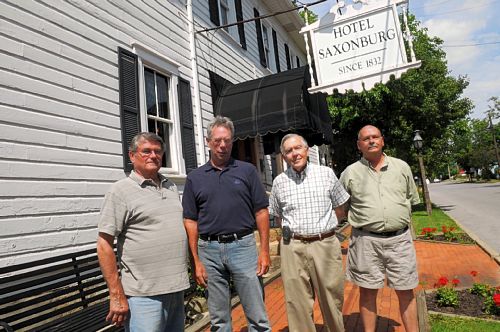
Saxonburg’s Main Street Has Money For a Facelift

Lake Fong/Post-Gazette From left, Chuck Matus, JRHSS Design Community; Ray Rush, Main Street Program manager; Dennis Chambers, chairman of Saxonburg Historical and Restoration Commission; and Gary Mullen, member of Saxonburg Historical and Restoration Commission outside the Hotel Saxonburg.
For all its charm and historical significance, Saxonburg’s Main Street is showing its age — and not in a way history aficionados prefer.
Some of the paved sidewalks are lifting; some street curbs are crumbling; and the green strip fronting the string of shops that comprise the bustling business district is looking a little ragged in spots.
It’s all about to be turned around, though.
Raymond Rush, the Main Street program manager, is using a recently awarded state grant of $373,027 from the Department of Community and Economic Development to design a renovation of the four-block Main Street. And he’s expecting the Pennsylvania Department of Transportation to follow with a $2.4 million grant for the work.
The grants are the culmination of a partnership between the borough and the John Roebling’s Historic Saxonburg Society, a nonprofit group that sponsors the Main Street program and has deemed as its mission “the historic restoration and economic development of Saxonburg.”
The society is named for the town’s founder, who left his mark on the world with his innovations in wire cable and bridge design. The organization began as the “main street committee” of a citizens group that worked on the borough’s comprehensive plan. Members began meeting around 2000, with Mr. Rush joining about 2002. The group incorporated as an official nonprofit in 2004. Mr. Rush is an artist and historian who lives on a 100-acre farm in Clinton and who founded the annual Penn’s Colony celebration 26 years ago.
Both he and his group have been busy working on a plan to bring a spark to the heart of Saxonburg.
Before the state grant was awarded in May, the society won a $50,000 matching grant for facades in 2006 that’s been used to leverage about $750,000 in private investment, Mr. Rush estimated. The program awarded $5,000 grants to local business owners to improve building facades, and the money had to be matched. Saxonburg also received an $85,000 infusion of money over the past two years from the state Community Development Block Grant program for storm water management.
“It’s been a very vital program,” Mr. Rush said.
Saxonburg’s Main Street captured designations as a historic district on the national level in 2004 and on the state level in 2008. Some 52 historic structures are located on the four-block Main Street between Butler Street on the west end of town and Rebecca Street on the east end.
Among the historic structures is the home of Mr. Roebling, a German immigrant who founded Saxonburg in 1831. The house serves now as the offices for the Memorial Church. He innovated wire cable to take the place of hemp ropes that pulled barges for the Allegheny Canal near Johnstown, and he designed suspension bridges. He died from an injury sustained while working on the Brooklyn Bridge.
As envisioned by the society, the borough and the Main Street businesses, the best way to bring a spark to the district is to revitalize it at its core by replacing the curbs in the four-block area, renewing the planter strip beside the curb and constructing new sidewalks. The project would be topped off with installation of street lights that replicate the style of old German pedestrian lights.
“The idea is to keep with the historic elements of mid-19th Century,” Mr. Rush said.
The total project cost is estimated at $2.4 million, and it will be done in two phases, he said. He expects construction to begin in 2011 and be finished within two years. The primary firms involved are Klavon Design Associates, located in Pittsburgh’s cultural district, and GAI Engineering Consultants of Homestead.
Mr. Rush credits the borough, local businesses and the dozen or so members of the historical society for about six years of work in bringing Saxonburg to the brink of such a major revitalization.
“It’s been steady, hard work by everyone,” he said.
Linda Kovacik, borough secretary/treasurer, put it simply: “It’s just what we’ve been hoping for.”
